The Man Who Mistook His Wife for a Hat Book Review
VerifiedAdded on 2023/06/18
|10
|3108
|126
AI Summary
This book review provides a comprehensive analysis of The Man Who Mistook His Wife for a Hat by Oliver Sacks. It covers the context, author, methodology, and legacy of the book. The book discusses neurological disorders and the deficiencies in the normal function of the brain. It includes case studies of patients with neurological disorders and how they adapt to their unusual situations. The legacy of the book is also discussed, including its influence on neuroscience and public understanding of the brain.
Contribute Materials
Your contribution can guide someone’s learning journey. Share your
documents today.

Book Review
Secure Best Marks with AI Grader
Need help grading? Try our AI Grader for instant feedback on your assignments.

Table of Contents
INTRODUCTION...........................................................................................................................3
THE CONTEXT OF THE BOOK...................................................................................................3
THE AUTHOR................................................................................................................................4
THE BACKGROUND AND PERSPECTIVE................................................................................4
METHODOLOGY AND METHODS............................................................................................5
THE BOOK ITSELF.......................................................................................................................6
THE LEGACY OF THE BOOK.....................................................................................................8
CONCLUSION................................................................................................................................8
REFERENCES..............................................................................................................................10
INTRODUCTION...........................................................................................................................3
THE CONTEXT OF THE BOOK...................................................................................................3
THE AUTHOR................................................................................................................................4
THE BACKGROUND AND PERSPECTIVE................................................................................4
METHODOLOGY AND METHODS............................................................................................5
THE BOOK ITSELF.......................................................................................................................6
THE LEGACY OF THE BOOK.....................................................................................................8
CONCLUSION................................................................................................................................8
REFERENCES..............................................................................................................................10

INTRODUCTION
“The man who mistook his wife for a hat” is classified into four parts and each of them
undertake the sequence of brief case studies considering several features including neurology. It
includes the discussion about the neurological disorders that could be interpreted as the
deficiency for the usual function of brain. Here, the character sack asserts that the pattern of
mental illness is too narrow as it marginalises the disorder of the brain's right hemisphere that
cannot simply be understood (Sacks and Walsh, 2018). The book is all about the discussion
regarding the mental factors, deficiencies and also profound mathematical gifts.
The effective examples are also discussed considering the example of sickness that could be
constructed as the benefit in suitable instances where patients have reported the sessions of
syphilis left them considering the feeling of energetic as well as lively. The discussion about the
neurological illness that can be formulated as the plenty of definite mental process as they talk
about the activity and the overall repercussions of the neurological abundance of day to day life
patients and after that took strict actions about the distress part of the brain. Further, sack found
that the prospect of the waging with intellectual disabled patient’s view of world.
THE CONTEXT OF THE BOOK
“The man who mistook his wife for a hat” is the book which is about Doctor P, who was
visual agnosia as before that Doctor P consults an ophthalmologist when he develops diabetes
thinking that it might impact his vision and also tell him that he does not have diabetes and rather
refers him to Sacks. Here, the writer Michael Nyman wrote the one act for the essential opera
“The man who mistook his wife for a hat” is classified into four parts and each of them
undertake the sequence of brief case studies considering several features including neurology. It
includes the discussion about the neurological disorders that could be interpreted as the
deficiency for the usual function of brain. Here, the character sack asserts that the pattern of
mental illness is too narrow as it marginalises the disorder of the brain's right hemisphere that
cannot simply be understood (Sacks and Walsh, 2018). The book is all about the discussion
regarding the mental factors, deficiencies and also profound mathematical gifts.
The effective examples are also discussed considering the example of sickness that could be
constructed as the benefit in suitable instances where patients have reported the sessions of
syphilis left them considering the feeling of energetic as well as lively. The discussion about the
neurological illness that can be formulated as the plenty of definite mental process as they talk
about the activity and the overall repercussions of the neurological abundance of day to day life
patients and after that took strict actions about the distress part of the brain. Further, sack found
that the prospect of the waging with intellectual disabled patient’s view of world.
THE CONTEXT OF THE BOOK
“The man who mistook his wife for a hat” is the book which is about Doctor P, who was
visual agnosia as before that Doctor P consults an ophthalmologist when he develops diabetes
thinking that it might impact his vision and also tell him that he does not have diabetes and rather
refers him to Sacks. Here, the writer Michael Nyman wrote the one act for the essential opera
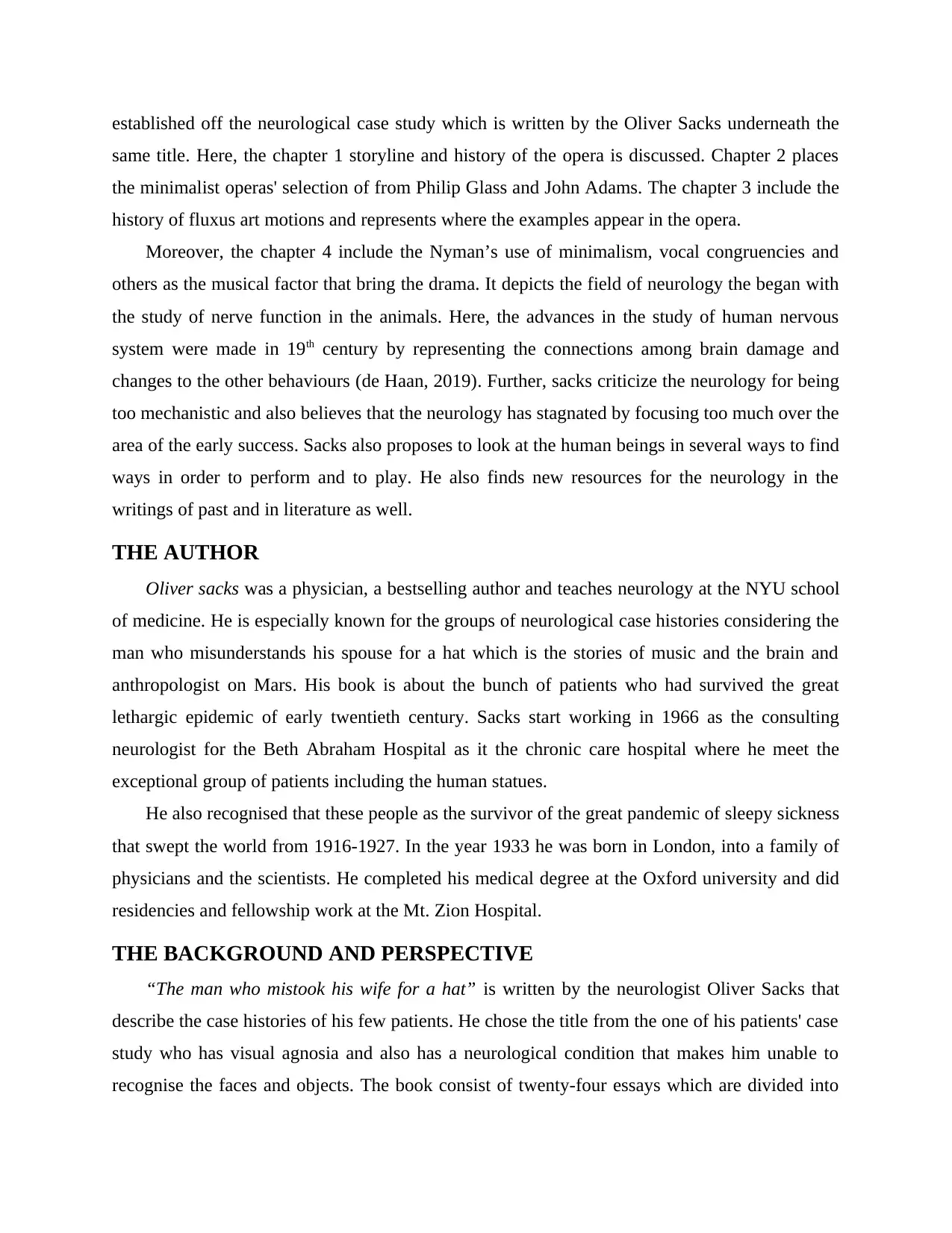
established off the neurological case study which is written by the Oliver Sacks underneath the
same title. Here, the chapter 1 storyline and history of the opera is discussed. Chapter 2 places
the minimalist operas' selection of from Philip Glass and John Adams. The chapter 3 include the
history of fluxus art motions and represents where the examples appear in the opera.
Moreover, the chapter 4 include the Nyman’s use of minimalism, vocal congruencies and
others as the musical factor that bring the drama. It depicts the field of neurology the began with
the study of nerve function in the animals. Here, the advances in the study of human nervous
system were made in 19th century by representing the connections among brain damage and
changes to the other behaviours (de Haan, 2019). Further, sacks criticize the neurology for being
too mechanistic and also believes that the neurology has stagnated by focusing too much over the
area of the early success. Sacks also proposes to look at the human beings in several ways to find
ways in order to perform and to play. He also finds new resources for the neurology in the
writings of past and in literature as well.
THE AUTHOR
Oliver sacks was a physician, a bestselling author and teaches neurology at the NYU school
of medicine. He is especially known for the groups of neurological case histories considering the
man who misunderstands his spouse for a hat which is the stories of music and the brain and
anthropologist on Mars. His book is about the bunch of patients who had survived the great
lethargic epidemic of early twentieth century. Sacks start working in 1966 as the consulting
neurologist for the Beth Abraham Hospital as it the chronic care hospital where he meet the
exceptional group of patients including the human statues.
He also recognised that these people as the survivor of the great pandemic of sleepy sickness
that swept the world from 1916-1927. In the year 1933 he was born in London, into a family of
physicians and the scientists. He completed his medical degree at the Oxford university and did
residencies and fellowship work at the Mt. Zion Hospital.
THE BACKGROUND AND PERSPECTIVE
“The man who mistook his wife for a hat” is written by the neurologist Oliver Sacks that
describe the case histories of his few patients. He chose the title from the one of his patients' case
study who has visual agnosia and also has a neurological condition that makes him unable to
recognise the faces and objects. The book consist of twenty-four essays which are divided into
same title. Here, the chapter 1 storyline and history of the opera is discussed. Chapter 2 places
the minimalist operas' selection of from Philip Glass and John Adams. The chapter 3 include the
history of fluxus art motions and represents where the examples appear in the opera.
Moreover, the chapter 4 include the Nyman’s use of minimalism, vocal congruencies and
others as the musical factor that bring the drama. It depicts the field of neurology the began with
the study of nerve function in the animals. Here, the advances in the study of human nervous
system were made in 19th century by representing the connections among brain damage and
changes to the other behaviours (de Haan, 2019). Further, sacks criticize the neurology for being
too mechanistic and also believes that the neurology has stagnated by focusing too much over the
area of the early success. Sacks also proposes to look at the human beings in several ways to find
ways in order to perform and to play. He also finds new resources for the neurology in the
writings of past and in literature as well.
THE AUTHOR
Oliver sacks was a physician, a bestselling author and teaches neurology at the NYU school
of medicine. He is especially known for the groups of neurological case histories considering the
man who misunderstands his spouse for a hat which is the stories of music and the brain and
anthropologist on Mars. His book is about the bunch of patients who had survived the great
lethargic epidemic of early twentieth century. Sacks start working in 1966 as the consulting
neurologist for the Beth Abraham Hospital as it the chronic care hospital where he meet the
exceptional group of patients including the human statues.
He also recognised that these people as the survivor of the great pandemic of sleepy sickness
that swept the world from 1916-1927. In the year 1933 he was born in London, into a family of
physicians and the scientists. He completed his medical degree at the Oxford university and did
residencies and fellowship work at the Mt. Zion Hospital.
THE BACKGROUND AND PERSPECTIVE
“The man who mistook his wife for a hat” is written by the neurologist Oliver Sacks that
describe the case histories of his few patients. He chose the title from the one of his patients' case
study who has visual agnosia and also has a neurological condition that makes him unable to
recognise the faces and objects. The book consist of twenty-four essays which are divided into
Secure Best Marks with AI Grader
Need help grading? Try our AI Grader for instant feedback on your assignments.

four sections and each dealing with the particular aspect of brain function. The author was
accustomed to thinking about the reactions of the neurological disease as the lack of some skill
or capacity from which the first part of the book depicts the effective manifestations of the
deterioration or incapacity that can be aroused by the damage of brain.
According to the author, there was no basic disorder of memory as anyone can carry their
intelligence and entertaining discussions and also play the piano with all their skills. It represents
the overall ability to recognise the objects and scenes that was still steadily and laboriously work
out what an object should be by analysing out loud what it appeared like. There is an idea of
losing mind of an individual which is comparatively easy to hold and despite from this, the
science fiction writer’s tendency for the brains in bottles (Verstraten, 2021). They represent the
refractory for any intense scientific examination as we have some awareness of which brain parts
and considering pathways which are included in the showing the image of mind of its body.
Here, the aim of author is about the basic understanding about the disorder of memory and
also include intelligence and include particular skills. Here, the history come alive through
insight of Sack, sympathetic retelling and the overall ability to find common metaphors in the
single factor. Further, Sack also takes into the another land, in which an individual find that these
tales of the neurological impaired can provide the better vision.
METHODOLOGY AND METHODS
For this, the further study, collection of data and information, Oliver Sacks always use the
individual opinion which he uses primary method of data collection in which he uses the
information about his patient’s personal experience and their cases which are unique and related
to the disorder of brain. The book of Oliver Sacks “The man who mistook his wife for a hat” is
case oriented instead of population based in which he collected details and information from the
personal experience of his patient.
Sack always saw himself as the story teller not a theorist as he was quite happy to present
the material of case which other individuals use in terms of devising the grand theories. Here,
each story tends to represent a theory as he was the only author who let his case histories shore
up to the brain's theory and other concerning organs that must be effectively implied as an
individual is capable of compensation (Novis, 2019). Here, the upcoming decades, his heritage
will be safe in the hearts and minds of millions of readers.
accustomed to thinking about the reactions of the neurological disease as the lack of some skill
or capacity from which the first part of the book depicts the effective manifestations of the
deterioration or incapacity that can be aroused by the damage of brain.
According to the author, there was no basic disorder of memory as anyone can carry their
intelligence and entertaining discussions and also play the piano with all their skills. It represents
the overall ability to recognise the objects and scenes that was still steadily and laboriously work
out what an object should be by analysing out loud what it appeared like. There is an idea of
losing mind of an individual which is comparatively easy to hold and despite from this, the
science fiction writer’s tendency for the brains in bottles (Verstraten, 2021). They represent the
refractory for any intense scientific examination as we have some awareness of which brain parts
and considering pathways which are included in the showing the image of mind of its body.
Here, the aim of author is about the basic understanding about the disorder of memory and
also include intelligence and include particular skills. Here, the history come alive through
insight of Sack, sympathetic retelling and the overall ability to find common metaphors in the
single factor. Further, Sack also takes into the another land, in which an individual find that these
tales of the neurological impaired can provide the better vision.
METHODOLOGY AND METHODS
For this, the further study, collection of data and information, Oliver Sacks always use the
individual opinion which he uses primary method of data collection in which he uses the
information about his patient’s personal experience and their cases which are unique and related
to the disorder of brain. The book of Oliver Sacks “The man who mistook his wife for a hat” is
case oriented instead of population based in which he collected details and information from the
personal experience of his patient.
Sack always saw himself as the story teller not a theorist as he was quite happy to present
the material of case which other individuals use in terms of devising the grand theories. Here,
each story tends to represent a theory as he was the only author who let his case histories shore
up to the brain's theory and other concerning organs that must be effectively implied as an
individual is capable of compensation (Novis, 2019). Here, the upcoming decades, his heritage
will be safe in the hearts and minds of millions of readers.
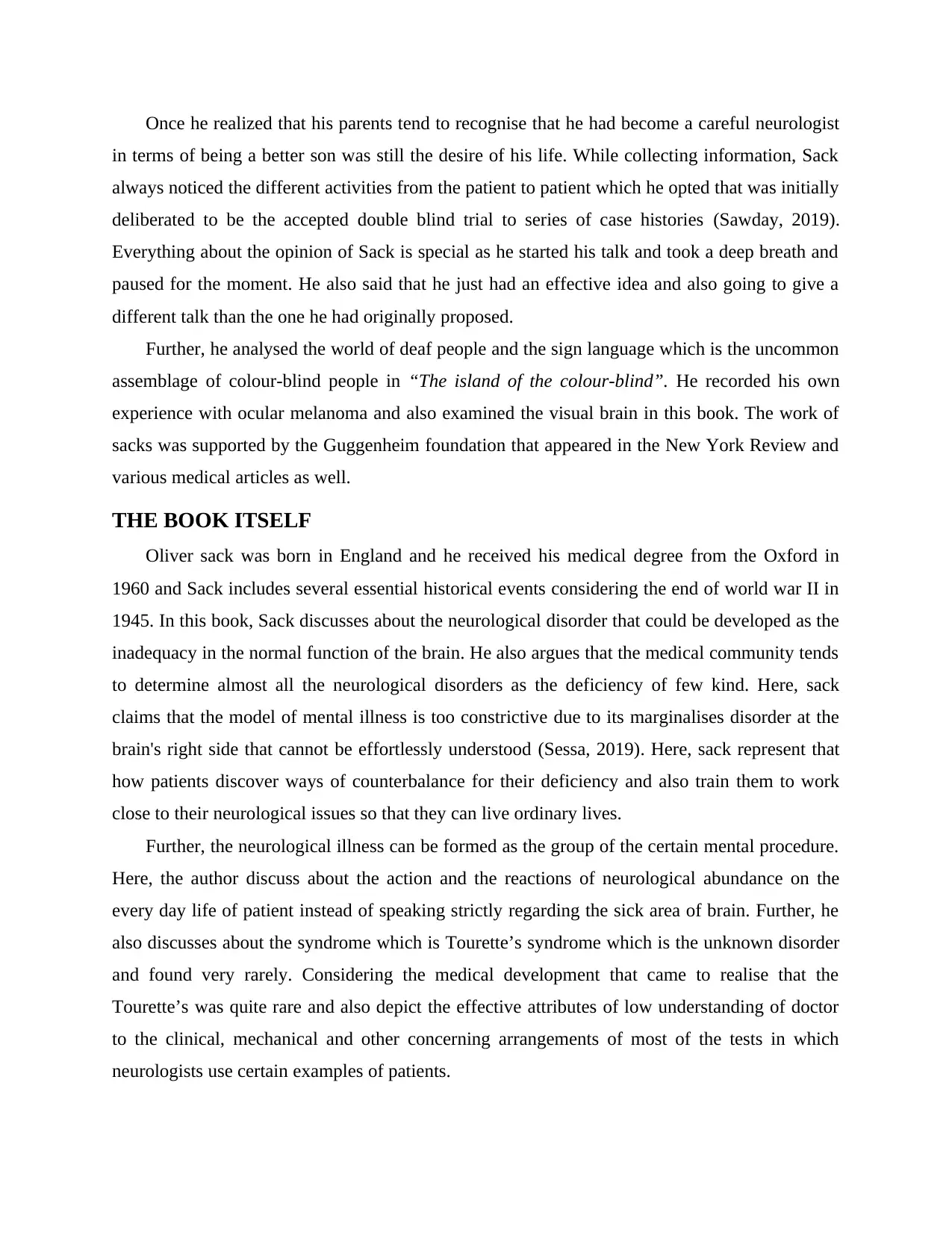
Once he realized that his parents tend to recognise that he had become a careful neurologist
in terms of being a better son was still the desire of his life. While collecting information, Sack
always noticed the different activities from the patient to patient which he opted that was initially
deliberated to be the accepted double blind trial to series of case histories (Sawday, 2019).
Everything about the opinion of Sack is special as he started his talk and took a deep breath and
paused for the moment. He also said that he just had an effective idea and also going to give a
different talk than the one he had originally proposed.
Further, he analysed the world of deaf people and the sign language which is the uncommon
assemblage of colour-blind people in “The island of the colour-blind”. He recorded his own
experience with ocular melanoma and also examined the visual brain in this book. The work of
sacks was supported by the Guggenheim foundation that appeared in the New York Review and
various medical articles as well.
THE BOOK ITSELF
Oliver sack was born in England and he received his medical degree from the Oxford in
1960 and Sack includes several essential historical events considering the end of world war II in
1945. In this book, Sack discusses about the neurological disorder that could be developed as the
inadequacy in the normal function of the brain. He also argues that the medical community tends
to determine almost all the neurological disorders as the deficiency of few kind. Here, sack
claims that the model of mental illness is too constrictive due to its marginalises disorder at the
brain's right side that cannot be effortlessly understood (Sessa, 2019). Here, sack represent that
how patients discover ways of counterbalance for their deficiency and also train them to work
close to their neurological issues so that they can live ordinary lives.
Further, the neurological illness can be formed as the group of the certain mental procedure.
Here, the author discuss about the action and the reactions of neurological abundance on the
every day life of patient instead of speaking strictly regarding the sick area of brain. Further, he
also discusses about the syndrome which is Tourette’s syndrome which is the unknown disorder
and found very rarely. Considering the medical development that came to realise that the
Tourette’s was quite rare and also depict the effective attributes of low understanding of doctor
to the clinical, mechanical and other concerning arrangements of most of the tests in which
neurologists use certain examples of patients.
in terms of being a better son was still the desire of his life. While collecting information, Sack
always noticed the different activities from the patient to patient which he opted that was initially
deliberated to be the accepted double blind trial to series of case histories (Sawday, 2019).
Everything about the opinion of Sack is special as he started his talk and took a deep breath and
paused for the moment. He also said that he just had an effective idea and also going to give a
different talk than the one he had originally proposed.
Further, he analysed the world of deaf people and the sign language which is the uncommon
assemblage of colour-blind people in “The island of the colour-blind”. He recorded his own
experience with ocular melanoma and also examined the visual brain in this book. The work of
sacks was supported by the Guggenheim foundation that appeared in the New York Review and
various medical articles as well.
THE BOOK ITSELF
Oliver sack was born in England and he received his medical degree from the Oxford in
1960 and Sack includes several essential historical events considering the end of world war II in
1945. In this book, Sack discusses about the neurological disorder that could be developed as the
inadequacy in the normal function of the brain. He also argues that the medical community tends
to determine almost all the neurological disorders as the deficiency of few kind. Here, sack
claims that the model of mental illness is too constrictive due to its marginalises disorder at the
brain's right side that cannot be effortlessly understood (Sessa, 2019). Here, sack represent that
how patients discover ways of counterbalance for their deficiency and also train them to work
close to their neurological issues so that they can live ordinary lives.
Further, the neurological illness can be formed as the group of the certain mental procedure.
Here, the author discuss about the action and the reactions of neurological abundance on the
every day life of patient instead of speaking strictly regarding the sick area of brain. Further, he
also discusses about the syndrome which is Tourette’s syndrome which is the unknown disorder
and found very rarely. Considering the medical development that came to realise that the
Tourette’s was quite rare and also depict the effective attributes of low understanding of doctor
to the clinical, mechanical and other concerning arrangements of most of the tests in which
neurologists use certain examples of patients.
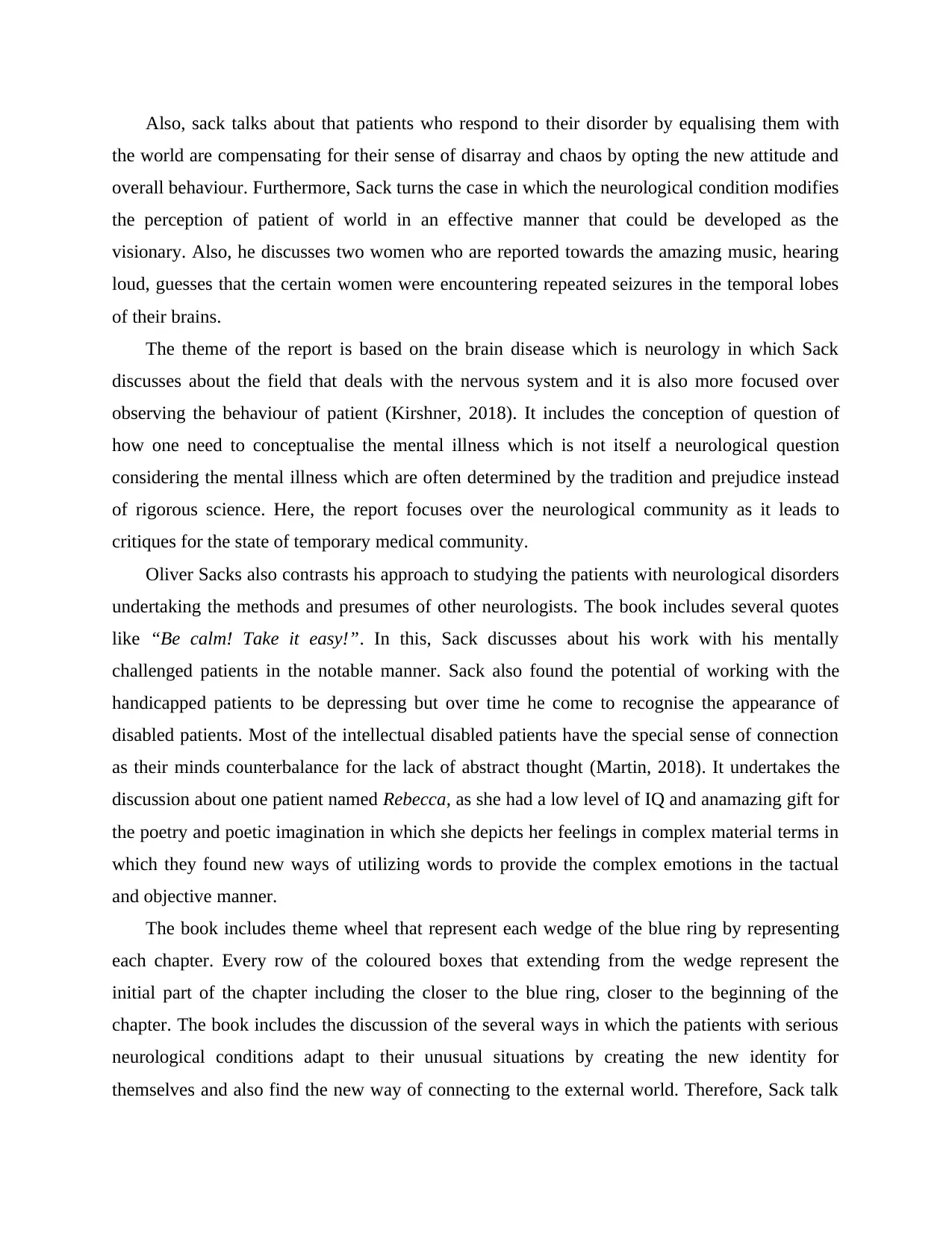
Also, sack talks about that patients who respond to their disorder by equalising them with
the world are compensating for their sense of disarray and chaos by opting the new attitude and
overall behaviour. Furthermore, Sack turns the case in which the neurological condition modifies
the perception of patient of world in an effective manner that could be developed as the
visionary. Also, he discusses two women who are reported towards the amazing music, hearing
loud, guesses that the certain women were encountering repeated seizures in the temporal lobes
of their brains.
The theme of the report is based on the brain disease which is neurology in which Sack
discusses about the field that deals with the nervous system and it is also more focused over
observing the behaviour of patient (Kirshner, 2018). It includes the conception of question of
how one need to conceptualise the mental illness which is not itself a neurological question
considering the mental illness which are often determined by the tradition and prejudice instead
of rigorous science. Here, the report focuses over the neurological community as it leads to
critiques for the state of temporary medical community.
Oliver Sacks also contrasts his approach to studying the patients with neurological disorders
undertaking the methods and presumes of other neurologists. The book includes several quotes
like “Be calm! Take it easy!”. In this, Sack discusses about his work with his mentally
challenged patients in the notable manner. Sack also found the potential of working with the
handicapped patients to be depressing but over time he come to recognise the appearance of
disabled patients. Most of the intellectual disabled patients have the special sense of connection
as their minds counterbalance for the lack of abstract thought (Martin, 2018). It undertakes the
discussion about one patient named Rebecca, as she had a low level of IQ and anamazing gift for
the poetry and poetic imagination in which she depicts her feelings in complex material terms in
which they found new ways of utilizing words to provide the complex emotions in the tactual
and objective manner.
The book includes theme wheel that represent each wedge of the blue ring by representing
each chapter. Every row of the coloured boxes that extending from the wedge represent the
initial part of the chapter including the closer to the blue ring, closer to the beginning of the
chapter. The book includes the discussion of the several ways in which the patients with serious
neurological conditions adapt to their unusual situations by creating the new identity for
themselves and also find the new way of connecting to the external world. Therefore, Sack talk
the world are compensating for their sense of disarray and chaos by opting the new attitude and
overall behaviour. Furthermore, Sack turns the case in which the neurological condition modifies
the perception of patient of world in an effective manner that could be developed as the
visionary. Also, he discusses two women who are reported towards the amazing music, hearing
loud, guesses that the certain women were encountering repeated seizures in the temporal lobes
of their brains.
The theme of the report is based on the brain disease which is neurology in which Sack
discusses about the field that deals with the nervous system and it is also more focused over
observing the behaviour of patient (Kirshner, 2018). It includes the conception of question of
how one need to conceptualise the mental illness which is not itself a neurological question
considering the mental illness which are often determined by the tradition and prejudice instead
of rigorous science. Here, the report focuses over the neurological community as it leads to
critiques for the state of temporary medical community.
Oliver Sacks also contrasts his approach to studying the patients with neurological disorders
undertaking the methods and presumes of other neurologists. The book includes several quotes
like “Be calm! Take it easy!”. In this, Sack discusses about his work with his mentally
challenged patients in the notable manner. Sack also found the potential of working with the
handicapped patients to be depressing but over time he come to recognise the appearance of
disabled patients. Most of the intellectual disabled patients have the special sense of connection
as their minds counterbalance for the lack of abstract thought (Martin, 2018). It undertakes the
discussion about one patient named Rebecca, as she had a low level of IQ and anamazing gift for
the poetry and poetic imagination in which she depicts her feelings in complex material terms in
which they found new ways of utilizing words to provide the complex emotions in the tactual
and objective manner.
The book includes theme wheel that represent each wedge of the blue ring by representing
each chapter. Every row of the coloured boxes that extending from the wedge represent the
initial part of the chapter including the closer to the blue ring, closer to the beginning of the
chapter. The book includes the discussion of the several ways in which the patients with serious
neurological conditions adapt to their unusual situations by creating the new identity for
themselves and also find the new way of connecting to the external world. Therefore, Sack talk
Paraphrase This Document
Need a fresh take? Get an instant paraphrase of this document with our AI Paraphraser
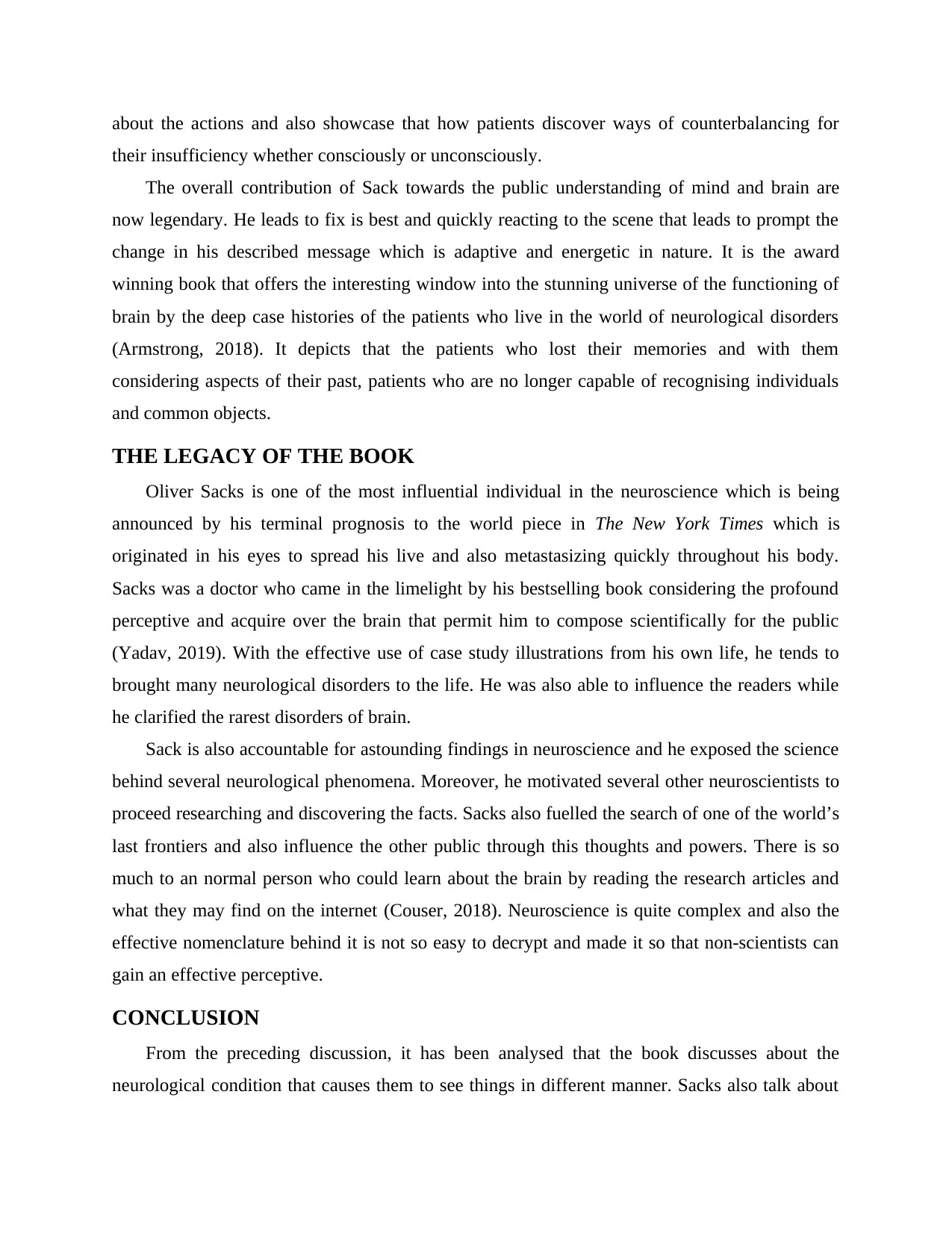
about the actions and also showcase that how patients discover ways of counterbalancing for
their insufficiency whether consciously or unconsciously.
The overall contribution of Sack towards the public understanding of mind and brain are
now legendary. He leads to fix is best and quickly reacting to the scene that leads to prompt the
change in his described message which is adaptive and energetic in nature. It is the award
winning book that offers the interesting window into the stunning universe of the functioning of
brain by the deep case histories of the patients who live in the world of neurological disorders
(Armstrong, 2018). It depicts that the patients who lost their memories and with them
considering aspects of their past, patients who are no longer capable of recognising individuals
and common objects.
THE LEGACY OF THE BOOK
Oliver Sacks is one of the most influential individual in the neuroscience which is being
announced by his terminal prognosis to the world piece in The New York Times which is
originated in his eyes to spread his live and also metastasizing quickly throughout his body.
Sacks was a doctor who came in the limelight by his bestselling book considering the profound
perceptive and acquire over the brain that permit him to compose scientifically for the public
(Yadav, 2019). With the effective use of case study illustrations from his own life, he tends to
brought many neurological disorders to the life. He was also able to influence the readers while
he clarified the rarest disorders of brain.
Sack is also accountable for astounding findings in neuroscience and he exposed the science
behind several neurological phenomena. Moreover, he motivated several other neuroscientists to
proceed researching and discovering the facts. Sacks also fuelled the search of one of the world’s
last frontiers and also influence the other public through this thoughts and powers. There is so
much to an normal person who could learn about the brain by reading the research articles and
what they may find on the internet (Couser, 2018). Neuroscience is quite complex and also the
effective nomenclature behind it is not so easy to decrypt and made it so that non-scientists can
gain an effective perceptive.
CONCLUSION
From the preceding discussion, it has been analysed that the book discusses about the
neurological condition that causes them to see things in different manner. Sacks also talk about
their insufficiency whether consciously or unconsciously.
The overall contribution of Sack towards the public understanding of mind and brain are
now legendary. He leads to fix is best and quickly reacting to the scene that leads to prompt the
change in his described message which is adaptive and energetic in nature. It is the award
winning book that offers the interesting window into the stunning universe of the functioning of
brain by the deep case histories of the patients who live in the world of neurological disorders
(Armstrong, 2018). It depicts that the patients who lost their memories and with them
considering aspects of their past, patients who are no longer capable of recognising individuals
and common objects.
THE LEGACY OF THE BOOK
Oliver Sacks is one of the most influential individual in the neuroscience which is being
announced by his terminal prognosis to the world piece in The New York Times which is
originated in his eyes to spread his live and also metastasizing quickly throughout his body.
Sacks was a doctor who came in the limelight by his bestselling book considering the profound
perceptive and acquire over the brain that permit him to compose scientifically for the public
(Yadav, 2019). With the effective use of case study illustrations from his own life, he tends to
brought many neurological disorders to the life. He was also able to influence the readers while
he clarified the rarest disorders of brain.
Sack is also accountable for astounding findings in neuroscience and he exposed the science
behind several neurological phenomena. Moreover, he motivated several other neuroscientists to
proceed researching and discovering the facts. Sacks also fuelled the search of one of the world’s
last frontiers and also influence the other public through this thoughts and powers. There is so
much to an normal person who could learn about the brain by reading the research articles and
what they may find on the internet (Couser, 2018). Neuroscience is quite complex and also the
effective nomenclature behind it is not so easy to decrypt and made it so that non-scientists can
gain an effective perceptive.
CONCLUSION
From the preceding discussion, it has been analysed that the book discusses about the
neurological condition that causes them to see things in different manner. Sacks also talk about
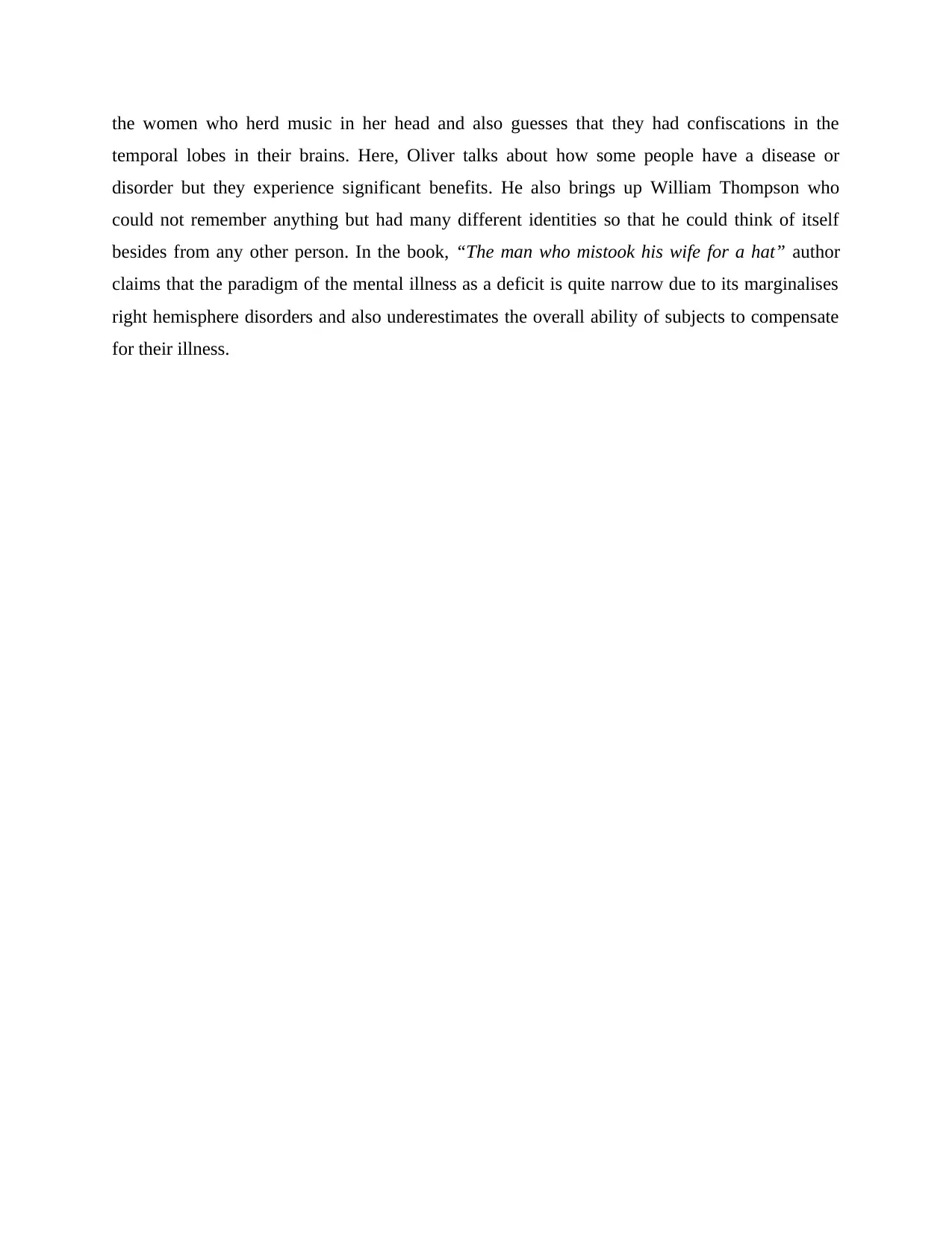
the women who herd music in her head and also guesses that they had confiscations in the
temporal lobes in their brains. Here, Oliver talks about how some people have a disease or
disorder but they experience significant benefits. He also brings up William Thompson who
could not remember anything but had many different identities so that he could think of itself
besides from any other person. In the book, “The man who mistook his wife for a hat” author
claims that the paradigm of the mental illness as a deficit is quite narrow due to its marginalises
right hemisphere disorders and also underestimates the overall ability of subjects to compensate
for their illness.
temporal lobes in their brains. Here, Oliver talks about how some people have a disease or
disorder but they experience significant benefits. He also brings up William Thompson who
could not remember anything but had many different identities so that he could think of itself
besides from any other person. In the book, “The man who mistook his wife for a hat” author
claims that the paradigm of the mental illness as a deficit is quite narrow due to its marginalises
right hemisphere disorders and also underestimates the overall ability of subjects to compensate
for their illness.

REFERENCES
Books and Journals
Verstraten, F., 2021. de Haan, E. 2019. Impaired Vision: How the Visual World May Change
After Brain Damage.
Sacks, O. and Walsh, J., 2018. On Writing-Up: Shame and Clinical Writing. In Shame and
Modern Writing (pp. 198-206). Routledge.
Novis, C., 2019. 50 Psychology Classics, Tom Butler-Bowdon. The greatest books distilled.
Your shortcut to the most important ideas on the mind, personality, and human
nature. South African Ophthalmology Journal, 14(1), pp.38-38.
Sawday, J., 2019. The Subtle Knot: Early Modern English Literature and the Birth of
Neuroscience by Lianne Habinek. Bulletin of the History of Medicine, 93(1), pp.117-
119.
Sessa, B., 2019. The Trials of Psychedelic Therapy: LSD Psychotherapy in America By Matthew
Oram Johns Hopkins University Press. 2018. 288 pp.£ 33.30 (hb). ISBN
9781421426204. The British Journal of Psychiatry, 215(2), pp.508-509.
Kirshner, H.S., 2018. The Perpetual Now: A Story of Amnesia, Memory, and Love.
Martin, E.N., 2018. Book Review of Scott A. Davison, On the intrinsic value of everything.
Yadav, M., 2019. Action, Body, Technology: A Study of Cave,“The Man Who” and Hands. The
Journal of Somaesthetics, 4(2).
Armstrong, D.M., 2018. The mind-body problem: An opinionated introduction. Routledge.
Couser, G.T., 2018. 5. Beyond the Clinic: Oliver Sacks and the Ethics of Neuroanthropology.
In Vulnerable Subjects (pp. 74-122). Cornell University Press.
Books and Journals
Verstraten, F., 2021. de Haan, E. 2019. Impaired Vision: How the Visual World May Change
After Brain Damage.
Sacks, O. and Walsh, J., 2018. On Writing-Up: Shame and Clinical Writing. In Shame and
Modern Writing (pp. 198-206). Routledge.
Novis, C., 2019. 50 Psychology Classics, Tom Butler-Bowdon. The greatest books distilled.
Your shortcut to the most important ideas on the mind, personality, and human
nature. South African Ophthalmology Journal, 14(1), pp.38-38.
Sawday, J., 2019. The Subtle Knot: Early Modern English Literature and the Birth of
Neuroscience by Lianne Habinek. Bulletin of the History of Medicine, 93(1), pp.117-
119.
Sessa, B., 2019. The Trials of Psychedelic Therapy: LSD Psychotherapy in America By Matthew
Oram Johns Hopkins University Press. 2018. 288 pp.£ 33.30 (hb). ISBN
9781421426204. The British Journal of Psychiatry, 215(2), pp.508-509.
Kirshner, H.S., 2018. The Perpetual Now: A Story of Amnesia, Memory, and Love.
Martin, E.N., 2018. Book Review of Scott A. Davison, On the intrinsic value of everything.
Yadav, M., 2019. Action, Body, Technology: A Study of Cave,“The Man Who” and Hands. The
Journal of Somaesthetics, 4(2).
Armstrong, D.M., 2018. The mind-body problem: An opinionated introduction. Routledge.
Couser, G.T., 2018. 5. Beyond the Clinic: Oliver Sacks and the Ethics of Neuroanthropology.
In Vulnerable Subjects (pp. 74-122). Cornell University Press.
1 out of 10
Related Documents
Your All-in-One AI-Powered Toolkit for Academic Success.
+13062052269
info@desklib.com
Available 24*7 on WhatsApp / Email
![[object Object]](/_next/static/media/star-bottom.7253800d.svg)
Unlock your academic potential
© 2024 | Zucol Services PVT LTD | All rights reserved.





